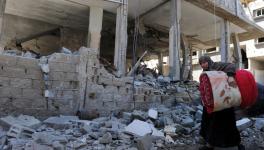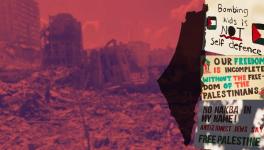Iran and Israel: Two sides of the West Asian Conflict
The Iran nuclear standoff has receded somewhat from public view. It does appear that diplomacy will now has chance in resolving this issue. The Geneva talks between Iran and the P5 has brought about some change in the scenario backed up by clear statements by both Russia and China that this was not the time for further sanctions.
Particularly important in this context is Russia’s turning down of Hilary Clinton’s proposal in Moscow to tighten sanctions on Iran. Putin later made publicly clear that Russia did not feel that this was the time to do so, a sentiment also echoed by Premier Wen Jiabao in Beijing last week.
However, the underlying issue – does Iran have a right to nuclear fuel technology guaranteed to it by Nuclear Non-Proliferation Treaty (NPT) – still remains. To the US and Israel, Iran retaining this right and implementing it is tantamount to building nuclear weapons and an existential threat to Israel and the west. Israel’s known nuclear weapons are neither a threat nor of concern to the security of the region, this is the asymmetric nuclear doctrine that the US and its allies want the world to accept. This was what was in view in IAEA, when the Non-aligned countries and the OIC moved a motion in IAEA that Israel joins the NPT and opens its nuclear facilities. The IAEA vote is important as on September 18, the IAEA General Council passed this resolution with a slender majority of 49-45 with 16 abstentions, in spite of opposition by the US and the major European nations.
To the US and its allies, the only issue in the Middle East has been Iran’s nuclear weapons, even though the 2007 National Intelligence Estimate (NIE) put together by 16 spook agencies of the US assessed that Iran was currently not building nuclear weapons. In spite of that, periodically, “new evidence”, very much in the mode of Iraq’s WMD’s surface and Iran is supposed to clarify them each time. Some time, it is a secret laptop with evidence of nuclear weapon designs, some times it is a file full of memos, now it is the secret Qom facility, which Iranians have now “admitted” to the IAEA. How a second enrichment facility on the lines of Natenz becomes a weapons program, and if so, why it was disclosed to IAEA remains unexplained. As long as the western media can be made to believe in this bogey of the Iranian bomb, the pressure on Iran to give up its nuclear enrichment program under the threat of military strike would continue.
A part of the problem that the US and Israel have in this “strategic” game, is that playing the same hand from the same deck as they did last time on Iraq. Iran is also quite a bit bigger than Iraq and its ability to strike back at the extended US forces in the region would be much more than Iraq’s. And even more important for any sane US policy in West Asia, the US needs Iran to extricate itself from its military misadventures in the region: both in Iraq and in Afghanistan, Iran is a key player. Striking at Iran or allowing Israel to strike Iran’s nuclear facilities will not be a “clean, surgical strike” but will have the consequences of taking down the entire Middle east in flames. Any country proposing it in a world teetering on the brink of an economic meltdown today would find very few takers. Even the neo-crazies in the US from Fox News and Washington Post are finding this a difficult sell.
So why did the Obama administration raise the ante with the Qom secret facility before the Geneva talks with Iran? This was the first time that Iran and the US were meeting to discuss the issue and it appears that the US wanted to raise the temperature to put pressure on Russia and China to impose more stringent economic sanctions on Iran. What the Iranians did in Geneva was to take this pressure off by allowing the bulk of their existing stockpile of low enriched uranium to be taken out for reprocessing by Russia and conversion to nuclear fuel rods France. These fuel rods are for an operating reactor that Iran runs for producing medical isotopes. This way, the world would see that Iran did not have enough enriched uranium for a bomb and therefore building up the bomb scare would be less and less credible.
For those familiar with the earlier round of Iran’s nuclear talks, this is what Iran had always on offer – they were willing to let their fuel be enriched either outside or in a multinational facility, provided they were allowed a small research facility for reprocessing. This was what the US and the P5 rejected earlier and said that Iran must give up its right to nuclear fuel enrichment – a right it enjoys under NPT. As some observers have noted, the current arrangement is a de facto return to Iran’s original offer and recognition that Iran has the right to enrich its fuel.
If Iran is not making the bomb, why is there so much noise about its nuclear weapons program? The issue on nuclear weapons is that it is not making the bomb that is difficult. The central technological challenge is the knowledge and facilities to create the fissile material in the first place. This, in nuclear parlance is “break-out” capability or “latent” weapons capability. Once a country has that, crossing the Rubicon is a political decision. Of course, it would have to do what North Korea did earlier – walk out of the NPT. It is Iran’s “break-out’ capability that is seen to be the leveller with Israel. For Israel and the US, any levelling of the field, even if it is merely theoretical at this stage, is an existential threat – Israel’s pre-eminent military power in the region is what allows it to violate all canons of international law and various resolutions of the United Nations.
If any doubts on the score on double standards of the US and its allies were to be seen, they were laid to rest on their reaction to the Goldstone report on Gaza and the IAEA vote. The US and its allies rejected the meticulous 575 page Goldstone report on Gaza as “one sided” and contended that Israel was fully capable of investigating war crimes committed by its “Defence Forces.” The record is to the contrary. “Nine months since the conflict ended, Israel is known to have interviewed only two Palestinian witnesses to any of the alleged crimes in Gaza, and convicted only one soldier, sentencing him to seven months in prison for the theft of a credit card.” (Human Rights Watch). This in a war that saw more than 1400 Palestinians killed, a majority of them civilians; this against 10 Israeli soldiers killed, out of which 4 died in “friendly” fire. Only 4 Israeli civilians died in the Katyusha rockets, stated to be the main reason for the Gaza attack!
Their record in IAEA was no different. Iran’s nuclear enrichment is a threat to the world; Israel’s nuclear weapons are there only for peace! The IAEA vote is also significant. It shows that the US stranglehold on world bodies is now slipping. That is why a resolution against Israel could be passed. For the rest of the world, West Asia is not just Iran – it is also Israel and Palestine. It is also about oil and the US hegemony over the region. This is what is at stake in West Asia.
Get the latest reports & analysis with people's perspective on Protests, movements & deep analytical videos, discussions of the current affairs in your Telegram app. Subscribe to NewsClick's Telegram channel & get Real-Time updates on stories, as they get published on our website.























